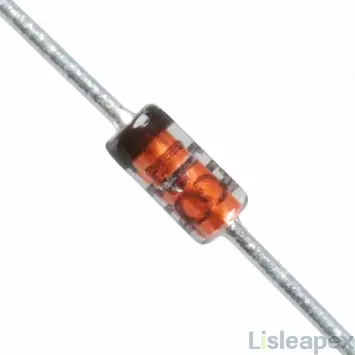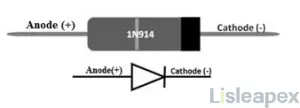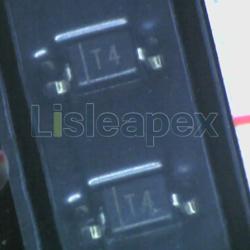Is 1N914 and 1N4148 Equivalent and Interchangeable?
The 1N914 and 1N4148 are very similar small signal diodes, and in many cases, they can be used interchangeably, especially in low-power and general-purpose applications. Both diodes share comparable electrical characteristics, such as forward voltage drop, maximum forward current, and maximum reverse voltage.

However, there are subtle differences between them:
- Forward Current Rating: The 1N4148 can handle slightly higher forward current (300mA) compared to the 1N914 (200mA).
- Reverse Recovery Time: The 1N4148 typically has a faster reverse recovery time than the 1N914. This characteristic might be important in high-frequency or fast-switching applications.
In many scenarios where the electrical specifications aren't critical or are within the overlap of both diodes' capabilities, they can be used interchangeably without significant issues.
1N914 vs 1N4148: Definition
1N914: This diode is a general-purpose silicon diode with moderate-speed switching. It has a forward voltage drop of around 0.6 to 0.7 volts and can handle a maximum continuous forward current of about 75 mA.
1N4148: Also a silicon switching diode, the 1N4148 is very much like the 1N914. It has a similar forward voltage drop and maximum continuous forward current capacity. The main difference is that the 1N4148 is often rated for a slightly higher reverse voltage (around 100 volts) compared to the 1N914 (around 75 volts).
1N914 vs 1N4148:Pinout


1N914 vs 1N4148: Features
1n914
- Maximum Forward Surge Current: 4A
- Reverse Recovery Time: 8ns
- Forward Continuous Current (If): 300mA
- Diode Type: Fast Switching Diode
- RMS Reverse Voltage: 75V RMS
- Package Type: DO-35
- Peak Repetitive Reverse Voltage: 100V
|
Parameter |
Value |
|
Base Part Number |
1N914 |
|
Capacitance @ Vr, F |
4pF @ 0V, 1MHz |
|
Current - Average Rectified (Io) |
200mA |
|
Current - Reverse Leakage @ Vr |
5μA @ 75V |
|
Diode Type |
Standard |
|
Manufacturer |
onsemi |
|
Moisture Sensitivity Level (MSL) |
1 (Unlimited) |
|
Operating Temperature - Junction |
150°C Max |
|
Packaging |
Tape & Box (TB) |
|
Part Status |
Obsolete |
|
Reverse Recovery Time |
4ns |
|
Reverse Recovery Time (trr) |
4ns |
|
Series |
-- |
|
Speed |
Small Signal =< 200mA (Io), Any Speed |
|
Voltage - DC Reverse (Vr) (Max) |
100V |
|
Voltage - Forward (Vf) (Max) @ If |
1V @ 10mA |
|
Other |
Base Product Number 1N914 |
|
Package |
DO-204AH, DO-35, Axial |
|
Product Status |
Obsolete |
|
Physical |
|
|
Mounting Type |
Through Hole |
|
Package / Case |
DO-204AH, DO-35, Axial |
|
Supplier Device Package |
DO-35 |
1n4148
Absolute Maximum Ratings:
- VRRM = 100 V (Maximum Repetitive Reverse Voltage)
- IO = 200 mA (Average Rectified Forward Current)
- IF = 300 mA (DC Forward Current)
- If = 400 mA (Recurring Peak Forward Current)
- IFSM = 1 A at 1 s pulse width; 4 A at 1 μs pulse width (Non-Repetitive Peak Forward Surge Current)
- Electrical and Thermal Characteristics:
VF = 1 V at 10 mA (Maximum Forward Voltage)
VR = 75 V at 5 μA; 100 V at 100 μA (Minimum Breakdown Voltage and Reverse Leakage Current)
trr = 4 ns (Maximum Reverse-Recovery Time)
PD = 500 mW (Maximum Power Dissipation)
1N914 vs 1N4148: Package

1N914 Package

1N4148 Package
1N914 vs 1N4148: Application
1n914 Application
- Signal Rectification: Converts AC signals to DC, commonly used in audio circuits and signal processing.
- Signal Demodulation: Separates modulated signals, often used in radio receivers.
- Switching Circuits: Due to its fast response, it's employed in high-speed switching applications in digital circuits.
- Clipping and Clamping: Limits voltage levels in circuits, protecting components from excess voltage.
- Voltage Regulation: Simple voltage regulation in circuits where stability is needed.
1n4148 Application
- General-Purpose Rectification: Converts alternating current (AC) signals to direct current (DC), commonly found in signal processing circuits.
- High-Speed Switching: Its fast switching characteristics make it suitable for high-frequency applications and digital circuits.
- Clipping and Clamping: Used to limit or regulate voltage levels in electronic circuits, protecting components from voltage spikes.
- Signal Demodulation: Extracts information from modulated carrier waves, often employed in radio receivers and communication devices.
- Voltage Protection: Guards sensitive components from reverse voltage, commonly used as a flyback diode in inductive circuits.
1n914 vs 1n4148: Manufacturer
ON Semiconductor
ON Semiconductor is indeed one of the major semiconductor manufacturers known for producing a wide range of electronic components, including diodes like the 1N914 and 1N4148. They have a significant presence in the industry, providing various semiconductor solutions for applications across different sectors such as automotive, industrial, consumer electronics, and more. ON Semiconductor's product portfolio covers diverse semiconductor devices, from discrete components like diodes to integrated circuits and power management solutions. Their manufacturing expertise and product quality have made them a trusted supplier in the semiconductor market.
Fairchild Semiconductor
Fairchild Semiconductor, historically a prominent semiconductor manufacturer, has been recognized for its contributions to the industry, including the production of diodes such as the 1N914 and 1N4148. Fairchild Semiconductor was known for its innovation and production of various electronic components, spanning from discrete semiconductors to integrated circuits.
While Fairchild Semiconductor has had a substantial impact on the semiconductor landscape, it's important to note that the company underwent changes over the years. In 2016, Fairchild Semiconductor was acquired by ON Semiconductor, leading to the integration of their product lines and technologies. As a result, many of Fairchild's product offerings, including certain diodes and semiconductor components, became part of ON Semiconductor's extensive portfolio.
Vishay
Vishay is a well-established global manufacturer of electronic components, including various types of diodes like the 1N914 and 1N4148. They are recognized for their extensive range of semiconductor products and passive electronic components used across multiple industries.
Vishay's diodes are known for their quality, reliability, and diverse applications. They produce a wide array of diodes catering to different voltage, current, and speed requirements. The 1N914 and 1N4148 are part of their portfolio, offering engineers and manufacturers options for small signal diodes suitable for applications in rectification, signal demodulation, switching, and voltage regulation.
Vishay's commitment to innovation and their comprehensive lineup of electronic components has made them a reputable and reliable choice for engineers and manufacturers seeking high-quality diodes and other semiconductor devices.
How to Choose between 1N914 vs 1N4148
Choosing between the 1N914 and 1N4148 diodes often depends on the specific requirements of your circuit or application. Here are some factors to consider when making a choice:
- Electrical Characteristics:
Forward Voltage Drop (VF): Both diodes have similar VF values at low currents, but 1N4148 might have slightly lower VF in practical applications.
Maximum Forward Current (IF): 1N4148 can handle a slightly higher forward current (300mA) compared to 1N914 (200mA).
- Reverse Voltage (VR):
Both diodes have a maximum reverse voltage of 100V, making them suitable for low to moderate voltage applications.
- Speed and Switching Applications:
1N4148 generally has a faster switching speed and lower reverse recovery time (trr) compared to 1N914. If you need faster response times in high-speed applications, 1N4148 might be more suitable.
- Availability and Cost:
Consider the availability and cost of each diode in your region or from preferred suppliers. Sometimes one might be more readily available or more cost-effective than the other.
- Application Specifics:
Review your circuit requirements. If it's a basic rectification or general-purpose application with lower current demands, either diode might suffice. For high-frequency circuits or situations requiring fast switching, the 1N4148 might be more appropriate due to its faster response.
 1N4148W-V
1N4148W-V
VISHAY
Discrete Semiconductor Products->Diodes->Rectifiers->Single Diodes
3~7 Days
In Stock:4,324
FAQ
-
Are there any notable differences in cost or availability between the 1N914 and 1N4148 diodes?
The 1N4148 is often slightly more readily available and might be marginally more expensive than the 1N914 due to its improved specifications.
-
Can the 1N914 or 1N4148 be used as a substitute for other diodes?
In many low-power and general-purpose applications, these diodes can serve as substitutes for each other and for other standard switching diodes.
-
Are there any differences in the physical package or size of these diodes?
Generally, both diodes have the same physical package and size, making them compatible in terms of mechanical dimensions.
-
What applications are suitable for the 1N914 and 1N4148 diodes?
Both diodes are commonly used in various electronic circuits for signal rectification, switching, and protection. They are frequently found in signal processing, RF applications, and digital circuits.
-
Can the 1N914 and 1N4148 be used interchangeably?
Yes, in many cases, the 1N914 and 1N4148 diodes can be used interchangeably without significant issues, especially in low-power or general-purpose circuits where the specific differences in performance may not be critical.
Stay updated with Lisleapex by signing up for the newsletter


 Congratulations On Your Successful Submission
Congratulations On Your Successful Submission
 Submission Failure
Submission Failure